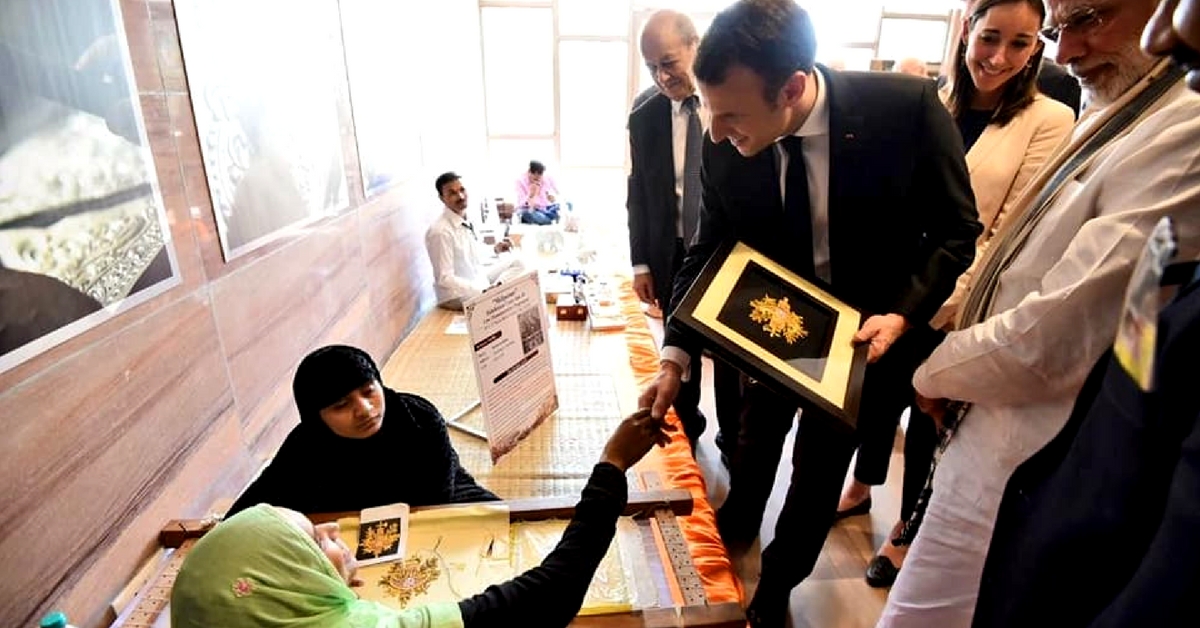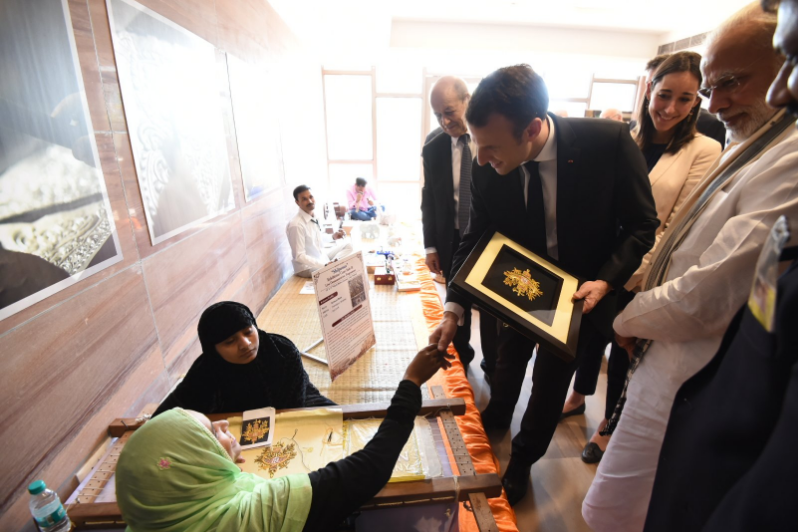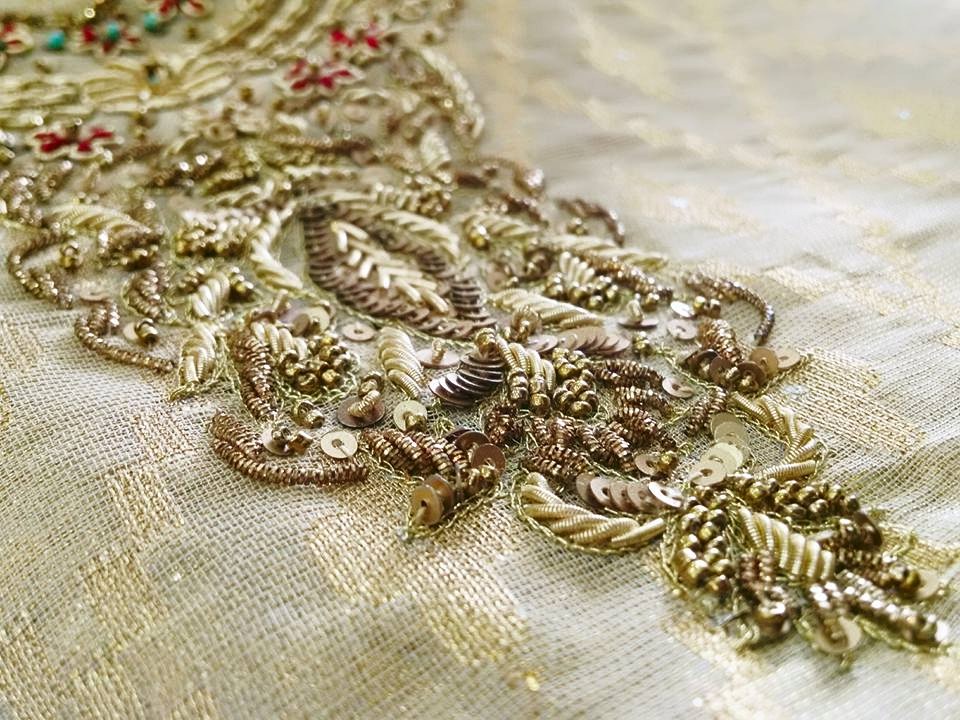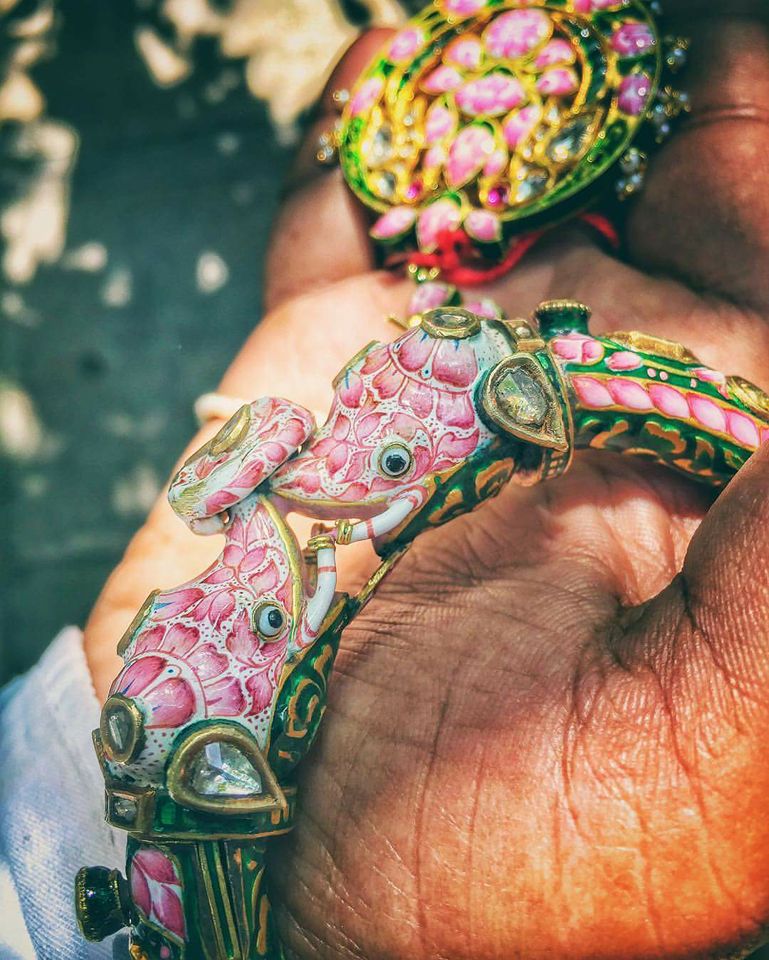Meet the Talented People Behind India’s Exquisite Gift to France’s First Couple!
While the Zardozi work was fashioned by master craftsman Mumtaz Ali of Lallpura, whose family has been engaged in the craft for many generations now, the pink-enamelled jewellery was created by Tarun Kumar.

During his visit to the Deen Dayal Hastkala Sankul in Bada Lalpur on Monday, French President Emmanuel Macron who was accompanied by Prime Minister Narendra Modi was given a display of exquisite handicrafts and artworks by local artisans.
But what outshone everything else were the intricately handcrafted gifts which were presented to the French Premier and First Lady—a framed Zari-embroidered piece showcasing the national emblem of France and a pair of Gulabi meenakari earrings!
While the Zardozi work was fashioned by master craftsman Mumtaz Ali of Lallpura, whose family has been engaged in the craft for many generations now, the pink-enamelled jewellery was created by Tarun Kumar.

When it comes to tracing down the origins of different traditional handicrafts across the country, it won’t come as a surprise as to how little we know about these artistic legacies that have been passed down over the centuries.
Take Zari work, for instance.
What used to be associated with the aristocratic & royal lineage in ancient India, is believed to have travelled all the way from a village by the same name in erstwhile Persia, where artisans used the skill of weaving thin threads of gold or silver onto fabrics, primarily made of silk.
However, the intricate art is more prominently known as Zardozi in its place of origin.
Produced by twisting a flattened metallic strip made from pure gold, silver or a metallic polyester film around a yarn of silk, cotton, or polyester, the zari threads are then processed to increase the brightness, giving it a rich and aesthetic appearance.

Through hours of needlework done on the floor, it is believed that the original Zari patterns were inspired by ancient beliefs and rituals practised by the artisans in the region.
Today, the ancient craft is practised by very few families in northern parts of the country and is being vehemently promoted by the government, lest the art form vanishes without a trace.
You may also like: The Link Between Modi, Obama and the Village of Nirona in Kutch!
As of the Gulabi Meenakari, which means pink enamelling, one can skim through the pages of Mughal history to trace the metal enamelling art of Meenakari that involved colouring the metallic surfaces through the fusion of brilliant colours.
The pink version, in particular, was brought to Varanasi by Persian enamellists during the early 17th century and reached its zenith of perfection at the Persian Court of Isfahan during the Qajar dynasty.
Unlike the vibrant souvenirs from Jaipur and Delhi with their distinctive red, green and blue enamelling, where the white portions are left stark, what makes Gulabi Meenakari iconic is the way the Varanasi meenakars (craftsmen) delicately add pink brush strokes to the predominant white enamel.

From religious figures of gods and goddesses on silver and gold sheets to various types of traditional ornaments and decorative items, the dexterity of the meenakars appears in the form of delicate motifs comprising phool-patti (flowers and foliage), peacocks, parrots and elephants, that personify the gold and silver embellishments.
You may also like: The PM’s Gift to Ivanka Was Quite Special. Know More About This Unique Art Form
Like Zari, even Meenakari is a slowly-dying art form, as only a handful of craftsmen have been carrying forward the legacy which was practised since the Mughal era.
We hope that with the French President’s visit and the global exposure that art forms like Zari and Gulabi Meenakari have received, there will still be a scope for these time-tested legacies to thrive.
Like this story? Or have something to share?
Write to us: [email protected]
Connect with us on Facebook and Twitter.
NEW: Click here to get positive news on WhatsApp!
If you found our stories insightful, informative, or even just enjoyable, we invite you to consider making a voluntary payment to support the work we do at The Better India. Your contribution helps us continue producing quality content that educates, inspires, and drives positive change.
Choose one of the payment options below for your contribution-
By paying for the stories you value, you directly contribute to sustaining our efforts focused on making a difference in the world. Together, let’s ensure that impactful stories continue to be told and shared, enriching lives and communities alike.
Thank you for your support. Here are some frequently asked questions you might find helpful to know why you are contributing?


This story made me
- 97
- 121
- 89
- 167











